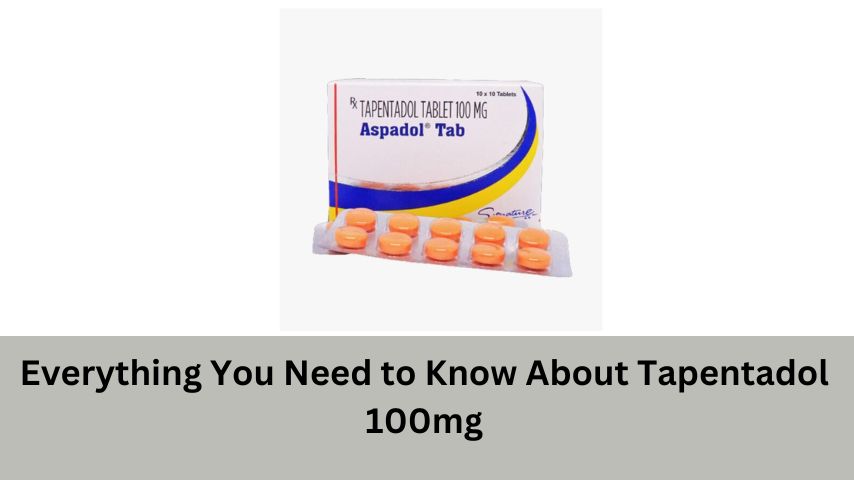Pain management is a crucial aspect of healthcare that affects the quality of life for many individuals. Tapentadol 100mg is a medication widely recognized for its effectiveness in treating moderate to severe pain. This guide aims to provide you with comprehensive information about Tapentadol 100mg, its benefits, how it works, its potential side effects, and more. Our goal is to present this information in a straightforward, easy-to-understand manner to ensure that everyone can comprehend and make informed decisions about their pain management options.
What is Tapentadol 100mg?
Tapentadol 100mg is a powerful pain relief medication that belongs to the class of drugs known as opioid analgesics, also commonly referred to as narcotics. It is used to manage moderate to severe pain, particularly when other pain relievers have not been effective. Tapentadol works by changing how the brain responds to pain, thus providing relief.
How Does Tapentadol 100mg Work?
To understand the effectiveness of Tapentadol 100mg in managing pain, it is essential to know how it operates within the body. Here’s a detailed breakdown:
H2: Action on the Nervous System
Tapentadol 100mg acts directly on the central nervous system (CNS) to alleviate pain. It binds to specific tiny areas called opioid receptors in the brain and spinal cord, which are crucial for transmitting the sensation of pain throughout the body.
Dual Mechanism of Action
Unlike typical opioids, Tapentadol 100mg has a dual mechanism of action. It not only works as an opioid agonist but also inhibits the reuptake of norepinephrine, a neurotransmitter that can modulate pain signals. This dual action allows Tapentadol to be effective in managing both nociceptive pain (caused by physical damage) and neuropathic pain (caused by nerve damage).
Benefits of Using Tapentadol 100mg
There are several reasons why healthcare providers might recommend Tapentadol 100mg:
Effective Pain Management
Tapentadol 100mg is particularly effective in treating chronic pain that does not respond well to other opioids. Its unique properties make it a valuable option for long-term pain management.
Lower Risk of Side Effects
Compared to other strong opioids, Tapentadol 100mg is associated with a lower risk of certain side effects such as gastrointestinal disturbances like nausea and constipation. This can significantly improve the quality of life for people who are on prolonged pain medication.
Versatility
The effectiveness of Tapentadol 100mg in treating a wide range of pain types, including both acute and chronic pain, makes it a versatile option in pain management.
How to Use Tapentadol 100mg Safely
Using Tapentadol 100mg safely is crucial to minimize risks and maximize its pain-relieving effects:
Follow Prescription Guidelines
Always use Tapentadol 100mg exactly as prescribed by your healthcare provider. The usual dose should not be exceeded, and the medication should not be taken more frequently than advised.
Be Aware of Interactions
Tapentadol 100mg can interact with various medications and substances, including alcohol, sedatives, and certain antidepressants, potentially leading to severe side effects. Always inform your healthcare provider about all other medications you are taking.
Monitor for Side Effects
While using Tapentadol 100mg, it’s important to monitor for any side effects. Some common side effects include dizziness, sleepiness, nausea, and vomiting. Immediate medical attention should be sought if symptoms like breathing difficulties, severe drowsiness, or confusion occur.
Potential Side Effects of Tapentadol 100mg
Although Tapentadol 100mg is generally well-tolerated, it can cause side effects, particularly if not used properly:
Common Side Effects
- Drowsiness
- Nausea and vomiting
- Headache
- Dizziness
Serious Side Effects
- Respiratory depression (extremely slowed breathing)
- Agitation or severe nervousness
- Allergic reactions (rash, itching, swelling)
Dependency and Withdrawal
As with other opioids, there’s a risk of developing dependence on Tapentadol 100mg. This risk increases with prolonged use. Withdrawal symptoms, such as restlessness, watering eyes, runny nose, nausea, sweating, and muscle aches, can occur if the medication is stopped abruptly.
Who Should Avoid Tapentadol 100mg?
Tapentadol 100mg is not suitable for everyone. Certain individuals should avoid using this medication:
Allergy to Tapentadol
Individuals who have a known allergy to Tapentadol or any of its components should not use this medication.
Severe Respiratory Conditions
People with severe respiratory conditions or uncontrolled asthma should avoid Tapentadol, as it can exacerbate breathing problems.
Pregnancy and Nursing
Tapentadol may not be safe for use during pregnancy or breastfeeding. Always consult a healthcare provider to discuss the best pain management strategies during these periods.
Conclusion
Tapentadol 100mg is a potent medication for pain management, suitable for situations where other pain relievers have failed. Its unique action helps manage various types of pain effectively, but it must be used responsibly under medical supervision to avoid potential risks. Understanding both the benefits and the safety precautions of Tapentadol 100mg will help individuals make informed decisions about their pain management strategies and achieve a better quality of life while dealing with chronic pain conditions.





